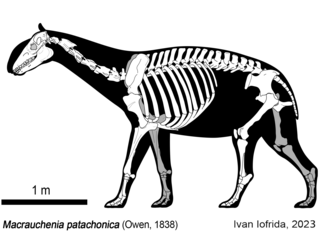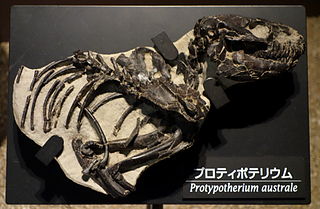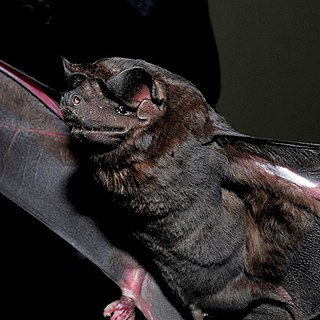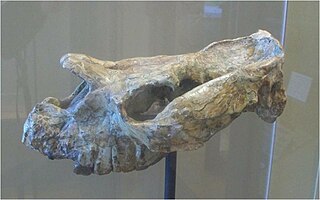
Nothofagus, also known as the southern beeches, is a genus of 43 species of trees and shrubs native to the Southern Hemisphere in southern South America and east and southeast Australia, New Zealand, New Guinea, and New Caledonia. The species are ecological dominants in many temperate forests in these regions. Some species are reportedly naturalised in Germany and Great Britain. The genus has a rich fossil record of leaves, cupules, and pollen, with fossils extending into the late Cretaceous period and occurring in Australia, New Zealand, Antarctica, and South America.

Sparassodonta is an extinct order of carnivorous metatherian mammals native to South America, related to modern marsupials. They were once considered to be true marsupials, but are now thought to be a separate side branch that split before the last common ancestor of all modern marsupials. A number of these mammalian predators closely resemble placental predators that evolved separately on other continents, and are cited frequently as examples of convergent evolution. They were first described by Florentino Ameghino, from fossils found in the Santa Cruz beds of Patagonia. Sparassodonts were present throughout South America's long period of "splendid isolation" during the Cenozoic; during this time, they shared the niches for large warm-blooded predators with the flightless terror birds. Previously, it was thought that these mammals died out in the face of competition from "more competitive" placental carnivorans during the Pliocene Great American Interchange, but more recent research has showed that sparassodonts died out long before eutherian carnivores arrived in South America. Sparassodonts have been referred to as borhyaenoids by some authors, but currently the term Borhyaenoidea refers to a restricted subgroup of sparassodonts comprising borhyaenids and their close relatives.

Macraucheniidae is a family in the extinct South American ungulate order Litopterna, that resembled various camelids. The reduced nasal bones of their skulls was originally suggested to have housed a small proboscis, similar to that of the saiga antelope. However, one study suggested that they were openings for large moose-like nostrils. Conversely, prehistoric pictographs by indigenous people seems to depict animals interpreted as macraucheniids with trunks. Their hooves were similar to those of rhinoceroses today, with a simple ankle joint and three digits on each foot. Thus, they may have been capable of rapid directional change when running away from predators, such as large phorusrhacid terror birds, sparassodont metatherians, giant short-faced bears (Arctotherium) and saber-toothed cats (Smilodon). Macraucheniids probably lived in large herds to gain protection against these predators, as well as to facilitate finding mates for reproduction.

Protypotherium is an extinct genus of notoungulate mammals native to South America during the Oligocene and Miocene epochs. A number of closely related animals date back further, to the Eocene. Fossils of Protypotherium have been found in the Deseadan Fray Bentos Formation of Uruguay, Muyu Huasi and Nazareno Formations of Bolivia, Cura-Mallín and Río Frías Formations of Chile, and Santa Cruz, Salicas, Ituzaingó, Aisol, Cerro Azul, Cerro Bandera, Cerro Boleadoras, Chichinales, Sarmiento and Collón Curá Formations of Argentina.

Borhyaenidae is an extinct metatherian family of low-slung, heavily built predatory mammals in the order Sparassodonta. Borhyaenids are not true marsupials, but members of a sister taxon, Sparassodonta. Like most metatherians, borhyaenids and other sparassodonts are thought to have had a pouch to carry their offspring around. Borhyaenids had strong and powerful jaws, like those of the unrelated placentalians Hyaenodon and Andrewsarchus, for crushing bones. Borhyaenids grew up to an average of 5 to 6 feet long. Borhyaena is the type genus of this group.

Cramauchenia is an extinct genus of litoptern South American ungulate. Cramauchenia was named by Florentino Ameghino. The name has no literal translation. Instead, it is an anagram of the name of a related genus Macrauchenia. This genus was initially discovered in the Sarmiento Formation in the Chubut Province, in Argentina, and later it was found in the Chichinales Formation in the Río Negro Province and the Cerro Bandera Formation in Neuquén, also in Argentina, in sediments assigned to the SALMA Colhuehuapian, as well as the Agua de la Piedra Formation in Mendoza, in sediments dated to the Deseadan. In 1981 Soria made C. insolita a junior synonym of C. normalis. A specimen of C. normalis was described in 2010 from Cabeza Blanca in the Sarmiento Formation, in sediments assigned to the Deseadan SALMA.

The black mastiff bat is a bat species. It ranges from the northern region of South America, most of Central America and parts of southern Mexico.

Leontiniidae is an extinct family comprising eighteen genera of notoungulate mammals known from the Middle Eocene (Mustersan) to Late Miocene (Huayquerian) of South America.
The Deseadan age is a period of geologic time within the Oligocene epoch of the Paleogene to the Early Miocene epoch of the Neogene, used more specifically within the SALMA classification of South America. It follows the Tinguirirican and precedes the Colhuehuapian age.

Proborhyaenidae is an extinct family of metatherian mammals of the order Sparassodonta, which lived in South America from the Eocene (Mustersan) until the Oligocene (Deseadan). Sometimes it has been included as a subfamily of their relatives, the borhyaenids. The largest species, Proborhyaena gigantea, is estimated to be about the size of a spectacled bear, with its skull reaching 60 cm (2.0 ft) in length, and body mass estimates up to approximately 90–200 kg (200–440 lb), making the proborhyaenids some of the largest known metatherians. Proborhyaenid remains have been found in western Bolivia, Uruguay, southern Brazil, and the provinces of Mendoza, Salta, and Chubut, in Argentina.

Pharsophorus is an extinct genus of borhyaenoid sparassodont that inhabited South America during the Middle to Late Oligocene epoch.
Groeberiidae is a family of strange non-placental mammals from the Eocene and Oligocene epochs of Patagonia, Argentina and Chile, South America. Originally classified as paucituberculate marsupials, they were suggested to be late representatives of the allothere clade Gondwanatheria. However, the relationship of the type genus, Groeberia, to Gondwanatheria has been firmly rejected by other scholars.
Ronwolffia is an extinct genus of horned armadillo (Peltephilidae), distantly related to the modern species of armadillos and to the extinct glyptodonts. It lived during the Oligocene in what is now the Salla Formation in Bolivia.

Eomorphippus is an extinct genus of notohippid notoungulate that lived from the Late Eocene to the Early Oligocene in what is today South America.
Termastherium is an extinct genus of leontiniid notoungulates that lived during the Early Oligocene of what is now Chile. Fossils of this genus have been found in the Oligocene-aged Abanico Formation of Chile.
Santiagorothia is an extinct genus of interatheriid notoungulate. It lived during the Early Oligocene, and its fossils were discovered in Argentina and Chile.
Fredszalaya is an extinct genus of omnivorous mammal, belonging to the order Sparassodonta. It lived during the Late Oligocene, and its fossilized remains were discovered in South America.
Paraborhyaena is an extinct genus of Sparassodont, belonging to the family Proborhyaenidae. It was one of the large terrestrial predators that roamed South America during the Oligocene.

Proborhyaena is an extinct genus of proborhyaenid sparassodont that lived during the Oligocene of what is now South America. It is considered to be the largest of the sparassodonts.
Rosendo is an extinct genus of notohippid notoungulates that lived during the Early Oligocene in what is now Argentina and Chile. Fossils of this genus have been found in the Sarmiento Formation and the Abanico Formations of Argentina and Chile.














